How to Plant and Grow Watermelon
Grow the juiciest, sweetest watermelon possible—all you need is a seed, well-drained soil, water, and sun.
Biting into a juicy slice of fresh watermelon is an essential part of summer. You can hardly have a barbecue or picnic without including a platter of watermelon because it's so refreshing on a hot day. If you've always picked your watermelons from the supermarket, you're seriously missing out on flavor. Growing your own and letting them ripen in the sun is a must for any true watermelon fan; they'll have better flavor, and you can take one straight from your garden to your table. All you need to get started is a sunny spot in your yard and a few seeds.
The first step in growing juicy and delicious watermelons is to choose the type you want to grow. There are three main kinds: Early season, main season, and seedless watermelons. Within those categories, you can choose flesh that's red, pink, yellow, or orange. An early-season watermelon is sometimes called an icebox melon because it grows to a petite size that easily fits on a refrigerator shelf. It takes the shortest time to mature, about 70 to 75 days. A main-season watermelon is larger and takes longer to ripen, usually 80 to 90 days.
Seedless watermelons are an interesting exercise in plant genetics. Plant breeders make several crosses to create seeds for watermelon plants that can't produce seeds themselves but can grow fruit when their blossoms are pollinated from regular seeded watermelons growing nearby. Seedless watermelons grow like other types of watermelons, but since they're not busy putting energy into producing seeds, seedless types are often sweeter, and the vines become more vigorous throughout the summer.
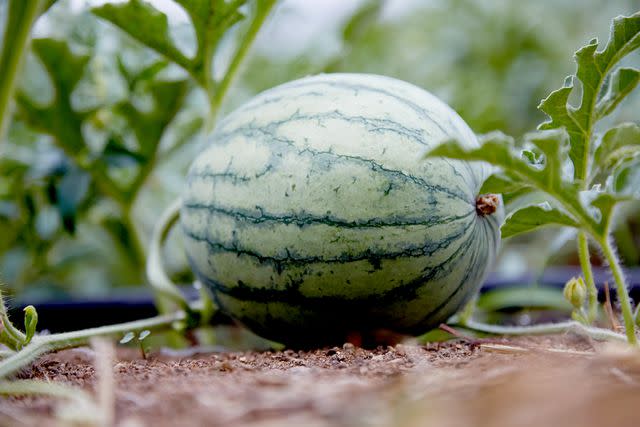
Where to Plant Watermelon
Plant watermelons in an area that receives full sun. Watermelons need rich soil that is well-drained and sandy. They grow best with a pH level between 6.0 and 6.5, a very narrow range. Test your soil before adding any compost or fertilizer to know if you need to add any nutrients and in what amounts.
How and When to Plant Watermelon
You can sow watermelons directly into a prepared garden bed when the soil temperature is above 65°F. Plant seeds 1 inch deep in slightly rounded hills 2 feet in diameter and 5 feet apart, placing five or six seeds on the top of each hill. After the watermelon seedlings are established, thin them to the three strongest on each hill.
In some northern climates, the growing season may not be warm long enough to produce good watermelons from seed. In that case, two to three weeks before your last frost in spring, start watermelon seeds indoors. Plant watermelon seeds in a soilless potting mix. Keep the seedlings warm and moist until outdoor temperatures consistently stay above 50°F or warmer. Don't start watermelon seeds too early because large plants transplant poorly into the garden. After they are planted, watermelons don't like their roots to be disturbed.
Once watermelon vines begin producing blossoms, the key to fruit set is pollination by bees. Avoid spraying for flying insects; chemicals can kill the beneficial bugs your plants need.
Related: Start Seeds Indoors to Get a Jump on Spring—Here's What You Need to Know
Watermelon Care Tips
Whether you like early season, main season, or seedless watermelons, growing your own watermelon is super simple. Be sure to keep your watermelon plants happy all season with the right amount of water, protection from diseases and pests, and the addition of extra nutrients to the soil.
Light
Watermelons need full sun—preferably 8 to 10 hours of direct sun—to thrive and produce the sweetest melons.
Soil and Water
Watermelons grow best in rich, well-draining soil with a pH between 6.0 and 6.5.
To suppress weeds and keep the soil moist, apply a 1- to 2-inch layer of organic mulch around watermelon vines when they reach 6 to 8 inches long. Frequently hand-pull weeds while they're small; if you wait until the weeds are large, their large root systems could disturb a watermelon's shallow roots.
Water your watermelon plants regularly when they're young. Typically, watermelon plants need 1-2 inches of water per week so that the soil stays moist but not wet. If you're not getting enough rain each week, make sure you give your plants an extra drink.
Temperature and Humidity
Watermelons grow best in long, hot summers that reach 80°F or higher. If summers are short or cool, consider laying black plastic over the soil for insulation. Make several holes in the cover to allow moisture to reach plant roots.
Watermelons grow equally well in any humidity level as long as the soil is well-draining.
Fertilizer
Fertilize watermelons right after transplanting them into the garden or when they develop into robust seedlings if growing from seed. Fertilize two more times during the growing season. Watermelons like a small amount of fertilizer over an extended period. Apply granular fertilizers every six weeks or liquid fertilizers every two weeks, following the product instructions. Use a product with a balanced ratio, such as 5-5-5.
Pruning
There is no need to prune watermelon vines. However, removing damaged or rotten fruit from watermelon vines allows the plant to direct more of its energy into producing healthy fruit.
Potting and Repotting
Balcony gardeners or those with small gardens can grow a watermelon vine in a container. Choose a large container—5 gallons or larger—with excellent drainage and fill it with lightweight potting soil, not heavy garden soil. Select a compact watermelon variety that produces small fruit. Don't try to grow large watermelon varieties in a container. Plant three seeds 1 inch deep (or transplant a seedling) after all chance of frost has passed and water well. In areas where space is limited, erect a teepee or trellis to support the vines. You'll need to train the vines up the support as they grow. After fruits form, they also need support, such as a fabric sling under each watermelon. The plant dies at the end of the season, so no repotting is needed.
Pests and Problems
Watermelon plants are susceptible to many of the same pests as other garden plants, including aphids, mites, thrips, beetles, and cutworms. Look for organic solutions, such as insecticidal soap, or physically remove large pests and drop them into soapy water. You don't want to use any pesticide on a plant with fruit you plan to eat.
If insect pests are a big problem, cover the young plants with row covers. Remove the row covers when watermelon vines begin blooming because they can prevent pollination.
How to Propagate Watermelon
The best way for home gardeners to propagate watermelon plants is with seeds harvested from an existing plant. Harvesting seed from a melon purchased at the grocery store is not usually successful because commercial melons are harvested before the seeds mature. Seeds don't continue to mature after a melon is harvested.
To harvest seed from a melon in the garden, wait until the melon matures past the point it would be harvested to be eaten. Wait until the curly tendril near it is completely dry before picking the melon and store it in a cool, dry place for two or three weeks. Then, scoop out the seeds and flesh and put them in a container of water. The healthy seeds sink to the bottom, and seeds that are not viable, along with most of the pulp, float to the top. Retrieve the healthy seeds and rinse any remaining pulp off them. Put the seeds on a paper towel in a sunny area for a week to dry. Then plant them in the garden after the weather warms or start them indoors before the spring frost.
Related: Healthy Watermelon Recipes That Will Make Your Summer
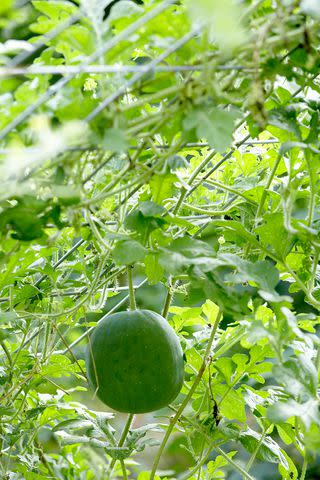
How to Get Sweet Watermelons
Why are some melons so sweet while others seem fibrous and tasteless? To get high sugar content, you need to keep watermelon plants happy all season with the right amount of water, protection from diseases and pests, and the addition of extra nutrients to the soil. An exceptionally cool growing season can also affect watermelon quality.
How to Grow Seedless Watermelons
Seedless watermelons may not germinate as well as other watermelons, so start more seeds than you need indoors in peat pots. Once they're transplanted into the garden, follow the same directions as for seeded watermelons. Seedless watermelons need pollen from a seeded type to produce, so plant a seeded variety nearby.
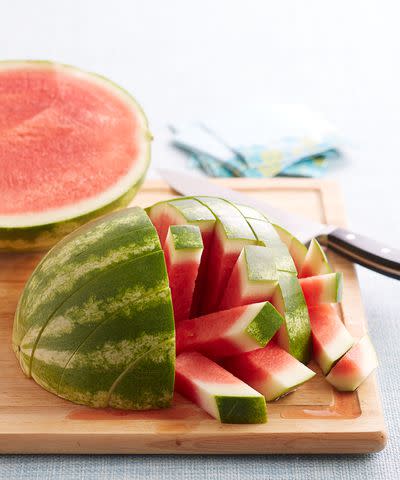
How to Tell When a Watermelon Is Ripe
Watermelons will not ripen off the vine. So how do you know when a watermelon is ripe? It's best not to rely on the time-honored "thump" method because it simply doesn't work. Instead, take a look at these telltale signs:
One of the best clues is to look at the spot where the melon has been resting on the ground. It has probably been pale green or white during the growing season. When it turns yellow, it's a sign of ripeness. Be careful not to rotate your melon too much when you check the coloring, or you may damage the vine. Just tip the fruit up enough to peek under it.
On ripe melons, the green, curly tendrils near the stem start to dry out and turn brown.
The surface color of the melon may appear dull instead of shiny.
The skin resists the poke of a fingernail.
Types of Watermelon
'Crimson Sweet' Watermelon
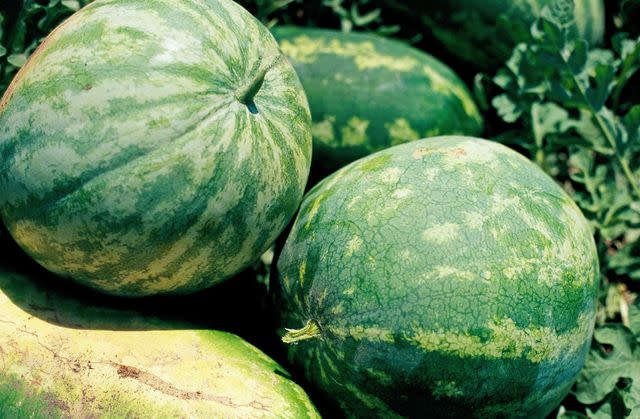
This variety produces 15- to 25-pound round melons that are light green with dark green stripes. The flesh is dark red and firm. The plants are resistant to anthracnose and fusarium wilt.
'Jubilee II Hybrid' Watermelon
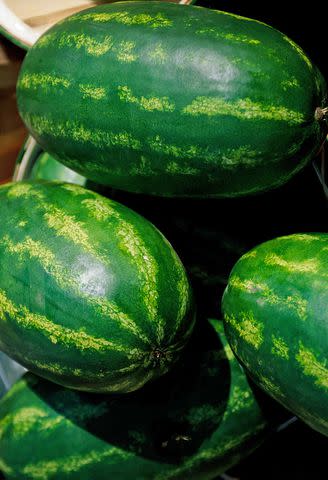
Citrullus lanatus 'Jubilee II Hybrid' offers oblong green-striped fruits that have red flesh and grow to 30 to 40 pounds. It has excellent anthracnose and fusarium wilt resistance. It is especially well suited to the Southeast.
'Moon and Stars' Watermelon
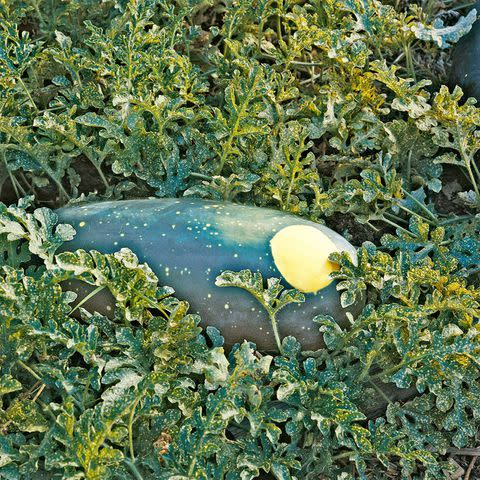
Citrullus lanatus 'Moon and Stars' is an heirloom named for the yellow splotches on the dark green rind. One or more large golden patches make up the "moon" and numerous smaller dots are the "stars." The flavorful red-fruited melons weigh 25 to 40 pounds.
'Sugar Baby' Watermelon
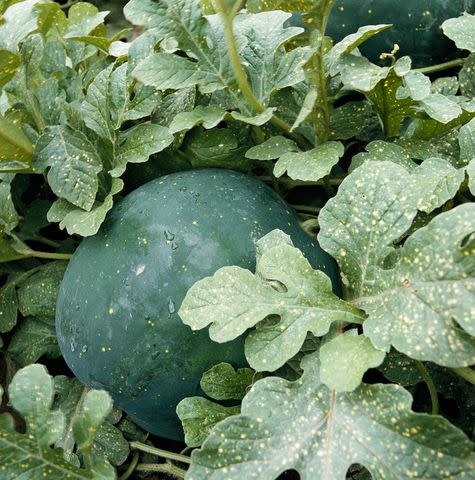
This type features round, deep green fruits with red flesh and a thick rind that resists cracking. They weigh 8 to 10 pounds each. The plants are compact, stretching only 3 to 4 feet long.
'Sweet Beauty Hybrid' Watermelon
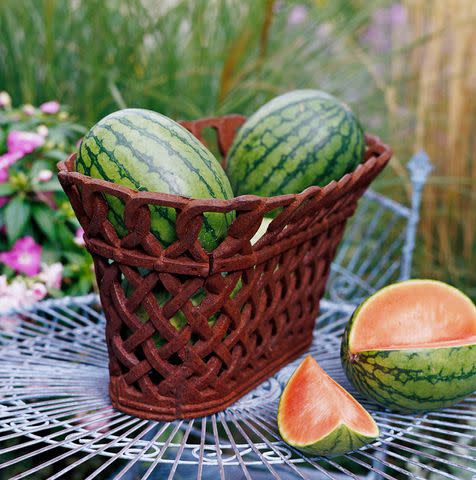
Citrullus lanatus 'Sweet Beauty Hybrid' bears 5- to 7-pound fruits that are a good size for small families or gatherings. The sweet red flesh has superior flavor. Fruits are borne on semi-upright vines that grow up to 3 feet tall.
'Tiger Baby' Watermelon
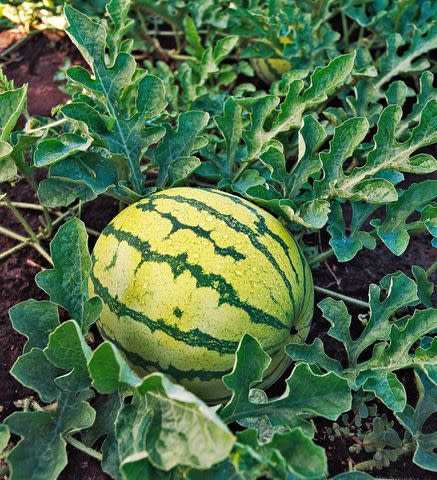
Citrullus lanatus 'Tiger Baby' bears striped round fruits that weigh 7 to 10 pounds. The pinkish-red flesh is dense and sweet. It has good resistance to fusarium wilt.
'Yellow Doll Hybrid' Watermelon
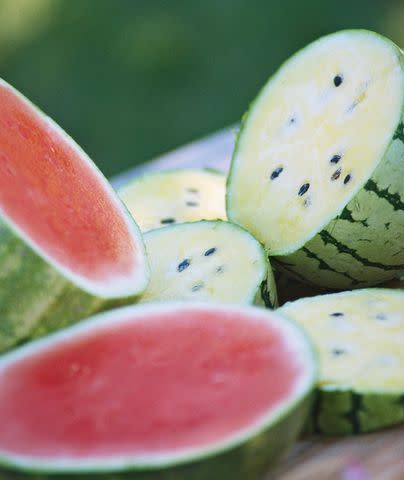
Citrullus lanatus 'Yellow Doll Hybrid' has unique yellow flesh. It produces 3- to 6-pound green-striped fruits on a compact vine.
Frequently Asked Questions
Which states grow the most watermelons?
Florida grows the most watermelons in the United States. Four states—Florida, California, Georgia, and Texas—grow 80 percent of the country's watermelon crop.
What are the white seeds in watermelons?
The white "seeds" are not seeds at all. They are empty seed coats that never developed seeds. Feel free to eat them; they are harmless.
For more Better Homes & Gardens news, make sure to sign up for our newsletter!
Read the original article on Better Homes & Gardens.

